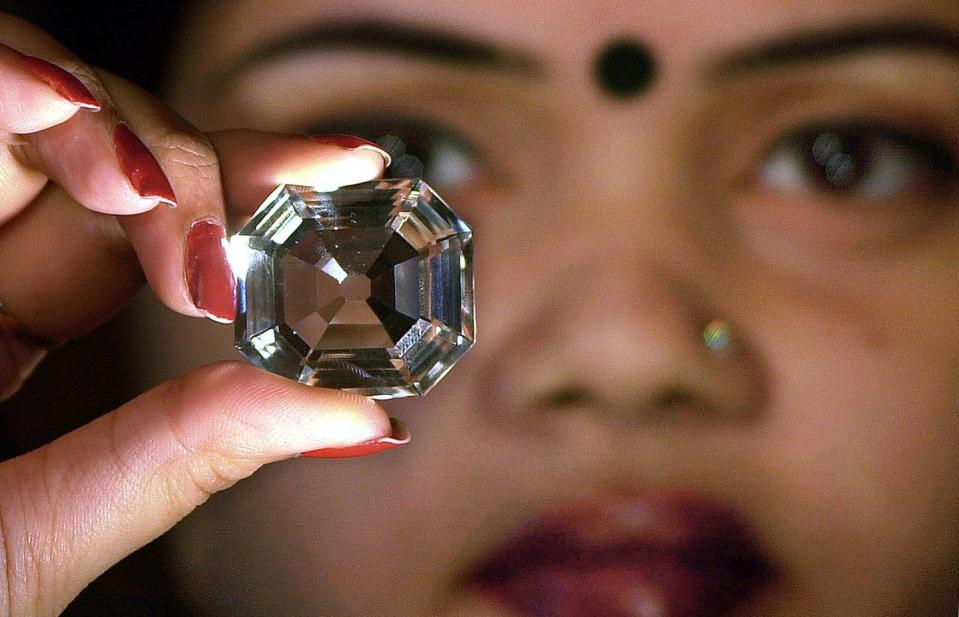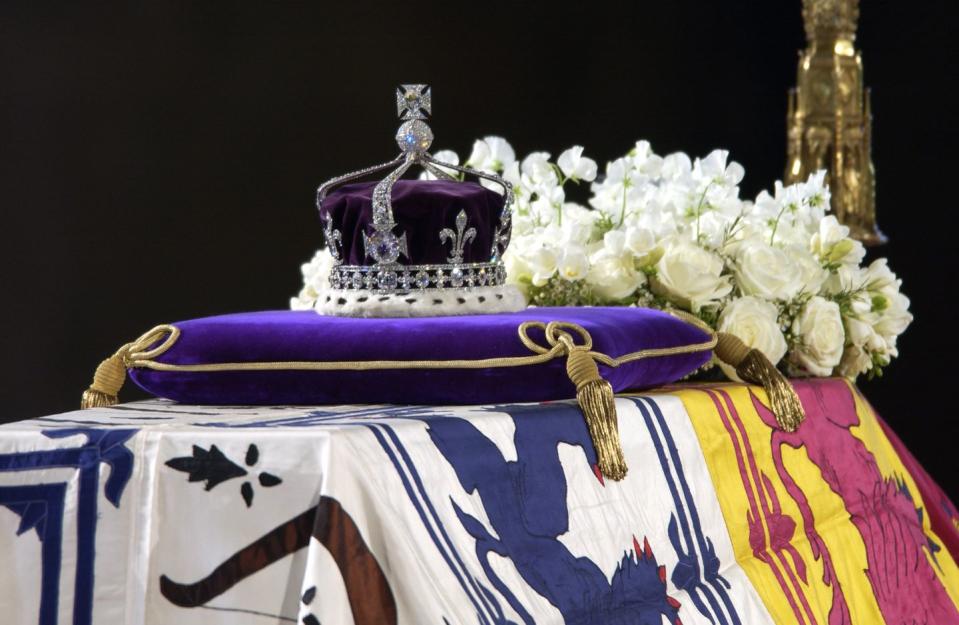The Messy—and Mysterious—Controversy Behind Queen Camilla's Coronation Crown
- Oops!Something went wrong.Please try again later.
- Oops!Something went wrong.Please try again later.
- Oops!Something went wrong.Please try again later.
The May 6 coronation of King Charles III and his wife Camilla, Queen Consort has generated controversy before it even begins, thanks to one of the largest cut diamonds in the world, and claims from multiple countries that it does not belong to the British monarchy.
Camilla will be crowned not with the Crown of Queen Mother Elizabeth, as would be tradition. Instead, she will wear the Crown of Queen Mary, which was made in 1911 for Queen Mary of Teck. This will mark the first time since 1727 that a Queen was crowned with something other than the consort’s crown.
The reason for the change is that the consort’s crown includes the Koh-i-Noor, a legendary 105-carat diamond whose name means “mountain of light” in Persian. Several countries have claimed rightful ownership of the diamond and demanded it back, including India, Pakistan, Iran, and Afghanistan.
“It is, in some respects, the ultimate blood diamond in South Asian history,” said Priya Atwal, author and historian at the University of Oxford. “Its origins are rather mysterious and quite legendary, and is this ultimate symbol of the internal political histories of the subcontinent,” Atwal told ABC News.
A Real-Life Lord of the Rings

The Koh-i-Noor is part of the Crown Jewels of the United Kingdom on display at the Tower of London, where it is advertised as a “symbol of conquest.” The diamond has changed hands many times over the years, belonging to the Mughal, Persian, Afghan, and Sikh empires before ending up with the British Empire in the mid-19th century.
“It’s the nearest thing to the ring of power in Lord of the Rings,” historian William Dalrymple told NPR. “Whenever it goes, it stirs up anger, greed, murder and bloodshed.”
According to legend, the diamond was first found alongside the holy Krishna River in southern India around the 12th century, when someone went to take a bath there and tripped over it. It belonged to the Hindu kings of the Kakatiya dynasty until they were vanquished in the 14th century.
By the 1600s, it ended up on the top of the Peacock Throne of Shah Jahan, leader of the Mughal Empire. It was taken again by the Iranian leader Nader Shah, who defeated the Mughal army in 1739.
It next ended up with Ahmad Shah Abdali, the founder of Afghanistan, which is why the Afghans—and even the Taliban—believe the diamond belongs to them. They possessed it for about a century, before it was captured yet again by Ranjit Singh, the king of Punjab, in 1813.
Falling into British Hands

When the East India Company captured Punjab in the mid-19th century, British officials discovered the Koh-i-noor in the possession of a 10-year-old Punjabi Sikh prince. He gave it to the British, who presented it to Queen Victoria. It was said to be a “gift” from the prince, but some historians say otherwise.
“I don't know of many ‘gifts’ that are handed over at the point of a bayonet,” Anita Anand, a journalist who wrote a book about the Koh-i-Noor, told the BBC.
Now in British hands, the Koh-i-Noor was incorporated into the Crown Jewels. Elizabeth, the wife of King George VI, wore it during her coronation in 1937, and then again for her daughter Queen Elizabeth II’s coronation in 1953. Elizabeth II herself is not believed to have ever worn it.
After Queen Elizabeth’s death last year, the Indian government has repeatedly asked for the Koh-i-Noor back. Other activists and cultural heritage experts have also called for its restitution to India, calling it an example of stolen heritage and a symbol of historical injustice.
“To Indians, it's actually a perfect, perfect metaphor for what India went through,” Anand told NPR. “It was reshaped and re-cut and diminished into something that suited a British palate and British needs.”
Navigating “Political Sensitivities”
The British government and monarchy have rarely discussed the Koh-i-noor publicly. In 2010, then-Minister David Cameron made a rare public comment about the diamond, saying that returning it to another country would set a risky precedent for British institutions.
“What tends to happen with these questions is that if you say yes to one, you suddenly find the British Museum would be empty,” Cameron told an Indian television station. “I think I am afraid to say, to disappoint all your viewers, it is going to have to stay put.”
Officially, Buckingham Palace says the decision for Camilla, Queen Consort to reuse Queen Mary’s crown, rather than wear the crown with the Koh-i-noor, was in the “interests of sustainability and efficiency.” But a source told the British media the decision was actually meant to avoid offending “political sensitivities.”
The crown Camilla will actually wear has no shortage of impressive jewelry. It includes 2,200 smaller diamonds, including some from Queen Elizabeth II’s personal collection. Some, like the diamonds known as Cullinan III, IV, and V, were mined from South Africa and have been called another symbol of British imperialism. South Africa wants those diamonds back as well.
“South Africans are increasingly saying this is again a massive symbol of how so much wealth, so much resource was drained from our country,” Atwal told ABC News. “If you swap the Koh-i-Noor for the South African diamonds, you're still in very tricky waters, and I think that is the thing that the monarchy is in, is this catch-22 situation.”

